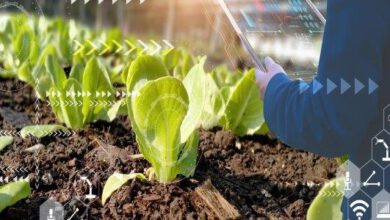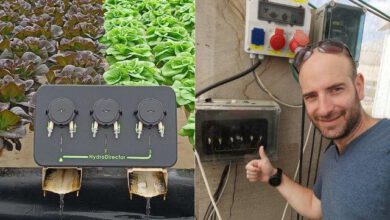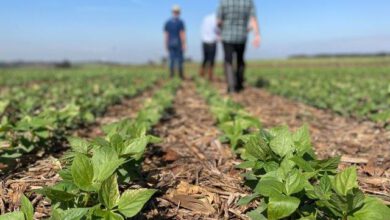Happy roots – happy shoots…
Precision agriculture technology zeroes in on the root zone
An interview with Mark Fishman mark@rootssat.com Roots' Agronomist & Sales Manager


Developmental agriculture leads farmers and researchers to search for ways and means to improve plant growing conditions so they can increase crop yield and accordingly improve farmers’ profitability.
Research conducted over the years concentrated mostly on plant’s environment and its interaction and influence on the stem, foliage (canopy) and output. The study of the root zone was neglected. During the last decade, a paradigm shift occurred in Agriculture Science and among farmers – it became clear that primary crucial plant development activity occurs in the root zone — from water, nutrient and fertilizer absorption to the plant’s hormonal activity which takes place in the roots.
ROOTS, a company established in 2012 by Mr.Boaz Wachtel and Dr. Sharon Devir, started out with the help of the Israeli Chief Scientist technological incubator. After a few years of research and field experiments, the team reached a conclusion, backed by solid science, that the most influential parameter in plant development, health and yield is dependent on optimal root zone temperatures. Based on these findings, the company developed and sells unique technology to warm or cool root zone in one system, thus revolutionizing Ag Tech and disrupting the entire Climate control segment.
In recent years, with the transition to industrial growing methods such as detached substrate growth, hydroponics (NFT) and aquaponics, ROOTS’s technology has experienced great momentum. In each of these new growing methods, the plant is removed from its natural environment, the soil, and it’s therefore important to provide it with an optimal environment and growing conditions.
Research and observations conducted by the company over the years in its research fields and those of growers, have yielded amazing results. Today ROOTS has technological ability enabling them to provide an environment and growing conditions to the root zone in each of the growing methods – whether in soil, hydroponics, pots or detached substrate.
Phenomena appearing in these observations strengthen the hypothesis that root zone temperature greatly influences plant health:
– Availability of soluble oxygen in the root zone, essential for plant development, is greater when the root zone is at optimal temperature. For example, in a situation of heat stress, optimal quantities of oxygen will not be available to the plant, and as a result developmental plant problems are liable to be created.
– During cold temperatures, phosphorus availability is problematic, and phosphorus deficiency does not allow optimal development; for example, avocado trees below 17º C.
– In leafy vegetables, high temperature in the root zone will adversely affect calcium availability, creating damage to the lettuce, which is liable to develop a phenomenon called “Tip Burn”. This encourages the appearance of other pathogens (i.e. Botrytis) that attach to the plant and cause great damage to the farmer.
– When the temperature rises above 35º C., the plant’s stomata close up, preventing photosynthesis and retarding growth – the upper section does not develop and the fruit doesn’t grow. Treating root zone temperature opens the stomata for several hours each day, which shortens the growing period and increases yield.
By contrast, in case of frost, the plant copes better when its root zone is warmed.
Mark brings an example from an open Sativa growing field in Washington. After a snow storm, the farmer saw that in fields next door that all plants died, but in the plot using ROOTS’s root-warming system, the plants were unharmed.

Untreated
Every farmer knows that a lack of nutrients weakens plants to the point of high susceptibility and appearance of diseases and fungi, but when optimal temperature is maintained in the root zone, the plant is healthier and less vulnerable and needs fewer sprays, thereby reducing expenses and increasing profitability.
Another advantage of applying the technology offered by ROOTS is the tremendous savings in energy – heating or cooling of the root zone, a limited well-defined area, reduces the need to heat and cool the entire greenhouse’s air and thus lowers expenses significantly.

Treated
How do we warm or cool the root zone? ROOTS offers three different configurations:
– Using a heat pump, which serves to warm or cool the root zone. ROOTS’ unique control system, together with sensors and an algorithm, enable greater energy efficiency, since the pump only operates when necessary.
– Utilizing an existing heat source in the soil. In this method, natural ground source heat exchange is transferred to the root zone by means of round coils located below the ground surface at a depth of 10 meters, where ground temperature is stable and equals the average annual air temperature at any location. That Temp is always warmer than top soil temp during the winter and cooler during the summer. Thus just with a circulation pump the technology is able to reduce root zone temperatures by up to 10 DC and save considerable operation expenses in any covered greenhouse and Hydroponics.
– Hybrid method combines the two systems. The root zone receives stable temp input relying on a small heat pump coupled with the heat exchangers from the soil. The hybrid system provides more exact temperatures as defined by each farmer, without investing all the energy, since the basic heat arrives from the soil and additional Delta temp is boosted by the heat pump.
ROOTS’ systems are easy to install, requiring just a few days and can be used in a new project or integrated in an existing one.
Mark emphasizes that the system is multi-seasonal, easily gathered when changing crops as the heat exchange probes can be detached and then easily reinstalled.
Another option, where the system includes built-in piping, utilizes the same pipes for drip irrigation and warming/cooling the roots, and represents huge savings in the required amount of piping, extensions and couplings.
The system’s usable life-span is at least ten years, so that despite the initial cost of the system, the return on investment is worthwhile: for Cannabis, the return ranges from one to two years, and in leafy vegetables and other plants – two to three years.
ROOTS is the pioneer researcher in the area of heating/cooling the root zone. In recent years many studies and installations have been carried out in this field in other countries as well, around the world. The
Company takes pride that their in-depth research has led to creation of a revolutionary solution whose results are well known in agricultural plots in Israel and beyond.
In 2017 ROOTS initiated intensive marketing activity, and continues to seek global distributors who can provide service and customer support for clients who purchase the system.
For More info : www.rootssat.com




